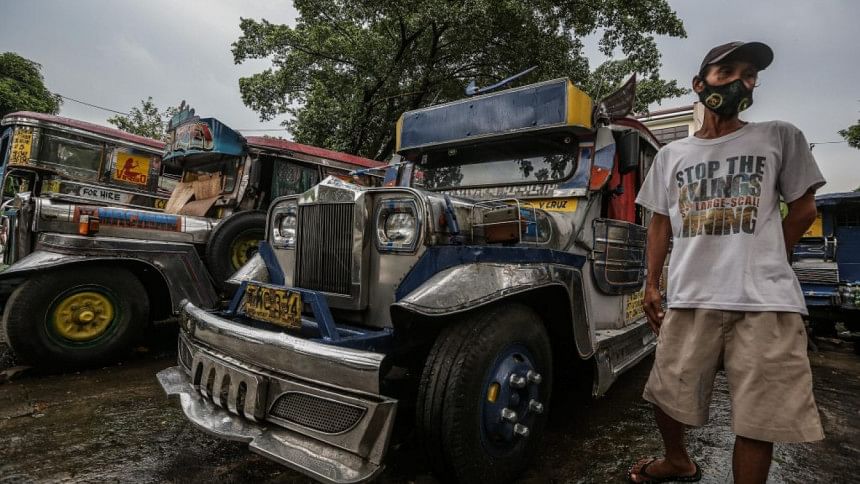End of the road for ‘The King’?

- The king of the road' prepares to step into history
- Jeepneys have been turned into living spaces
- PUV modernization and COVID-19 push the jeepneys off the streets
- The plight of the jeepney driver
The Pinoy jeepney, fondly known as the "king of the road," is about to step into the pages of history, pushed by the uncompromising situation created by the pandemic.
It is a sad exit, with many of its loyal subjects, the drivers, converting their jeepneys into living spaces just to survive in the time of the lockdowns to prevent the spread of the coronavirus disease (COVID-19). Meanwhile many drivers have resorted to begging beside large signs stating their plight.
But the plight of the jeepney drivers started long before COVID-19. The jeepney's inefficient engine and lack of safety features started the countdown to the end of the jeepney.
And then came the Public Utility Vehicle Modernization Program which was initiated in June 2017. Described by the Department of Transportation (DOTr) as the "biggest transformational initiative" of the administration, the program aims to modernize PUVs to improve the country's transport system and lessen air pollution brought by old and dilapidated units.
The DOTr said modern PUJs conform with the existing environmental and product standards set by the Bureau of Standards, are equipped with safety features, as well as a Euro-4 compliant engines which will produce less emission and cause less pollution, or none at all.
Still, the jeepneys stubbornly stood their ground, supported by a loyal group of drivers whose livelihoods depend on that vehicle.
But the COVID-19 pandemic changed all that. In March this year, the government imposed a lockdown in Luzon island, and was followed in the other islands. All forms of public transportation were suspended, the jeepney included.
For at least four months, jeepneys went on "leave" and were parked along public roads, empty lots, under bridges, in the parks. Many of them were turned into living quarters for the drivers and their families.
When the quarantine restrictions were lifted allowing limited forms of transportation to ply their routes, the jeepney was the last one to be allowed to operate. However, only about 7,000 of them were given permits to operate but on very limited routes.
Life of a jeepney driver
Even before the pandemic, life has been hard for the jeepney driver. But Ricardo Legaspi 56, who has worked as a jeepney driver for almost his entire life still found it a bearable life.
For 15 hours a day, Ricardo, or Mang Ric, transported commuters in his 12-seater jeepney along the Vito Cruz-Cubao route. The income he got could provide the needs of his wife, four children, and three grandchildren.
But Mang Ric's life took a hard turn when the pandemic came and the government imposed a strict lockdown mid-March. Suddenly, his only source of income – and that of thousands of PUV drivers and their families – disappeared because all modes of public transportation were suspended.
"Bago mag-lockdown, maganda pa ang kinikita namin noon dahil syempre mahaba ang oras namin. Nakakain kami ng tama, ng nasa ayos, pati apo ko nabibigyan ko ng panggatas, mga panggastos. Ngayon, walang-wala na talaga (Before lockdown, we still had a stable income as we had longer time on the road. We were able to eat at least three times a day, I could even provide my grandchildren with their needs. I really have nothing now.)," Mang Ric said.
First to go was their rented house. For almost five months now, Mang Ric and his wife Anna, 50, have been living inside their jeepney parked in a garage in Marikina City.
He said they used to rent an apartment but to cut that expense, they decided to live in their jeepney.
Mang Ric still sees himself lucky because a cause oriented group checks on them, donating food –enough for his family and fellow jeepney drivers to survive for many days.
We learned that 12 jeepney drivers, including Mang Ric, and their families have been staying inside their jeepneys since March, all of them doing odd jobs just to put food on their tables.
"It is difficult to always depend on others so we are looking for sidelines — repairing houses, hauling woodchops — it helps us survive. We can't leave or go anywhere to find work because we are not allowed to do so."
'Neglected, left behind'
Mang Ric was among the thousands of jeepney drivers in the metropolis who share the sentiment that they have been "neglected and left behind by the government," said George San Mateo, president emeritus of transport group Pinagkaisang Samahan ng mga Tsuper at Opereytor Nationwide (PISTON).
When travel restrictions were lifted during the general community quarantine (GCQ) in June, traditional jeepneys were the last to resume operations among mass transport options, only allowing 7,000 units to ply in Metro Manila, out of the estimated 55,000 PUJs in the region.
This was because traditional PUJs are placed at the bottom of the "hierarchy" of public transport, due to its limited capacity to provide features required for the "new normal" in the transportation sector, such as social distancing and cashless payment, said Land Transportation Franchising and Regulatory Board (LTFRB) chairman Martin Delgra III.
However, San Mateo said a large number of those who were given the green light to operate did not return on the roads due to difficult requirements imposed by the LTFRB such as the need for barriers between passengers, among others.
Aside from this, transport groups also claimed that this was just a way of the government to slowly phase out traditional jeepneys to pave the way for modernized and electric units as part of the implementation of the administration's PUV modernization program.
When did this situation all start?
The Philippine jeepney, which have earned the nickname "King of the Road" for their penchant for stopping anywhere, anytime, started conquering the road when American troops left the Philippines after World War II, and hundreds of second-hand military jeeps were sold or given to locals, historians said.
Those jeeps were later modified and emerged as a popular and cheap mode of mass public transport. When the Philippine government recognized its widespread use, systems were imposed to regulate them, such as requiring licensed plates, rationalized routes, and fare rates.
PUV Modernization Program
Mang Ric admitted that their hopes to go back to their usual driving routine were still unclear as the fate of traditional jeepneys remains uncertain with the implementation of the PUVMP.
The Department of Transportation (DOTr) said operators and drivers of all modes of road transport including bus, taxi, UV Express and jeepney must have consolidated their fleets under the PUVMP until December 31, or their franchise will expire.
The new deadline marks the end of the three-year transition period of the program which aims to replace old and dilapidated PUVs with modern vehicles powered by clean electric engines and supported by safety features, as well as an automated fare collection system.
At least 180,000 jeepneys around the country will be replaced under this program, the LTFRB said.
While the PUVMP covers all forms of road transport, no other group is firmer to stand against the program than the jeepney sector, which has staged many protest actions against the implementation of the program.
Amid protests, DOTr Assistant Secretary Goddess Libiran explained that the PUVMP will benefit both the commuters and the drivers. Under the program, Libiran said drivers could have a salary with fixed working hours as it aims to remove the "boundary system" among PUVs, similar to the situation of Mang Ric.
The DOTr official also belied claims that the department is taking advantage of the pandemic to ease out conventional jeepneys and immediately implement the PUVMP.
"We are not taking advantage of the pandemic. We are ahead of the pandemic. The PUV Modernization started in 2017. The operators were given a transition period of three years to consolidate and shift to modernized units and it was even extended until December this year," she said.
The DOTr and the LTFRB emphasized that there is no stopping the program and it will push through amid the pandemic.
This means the "King of the Road" will soon retire and pass its crown to a modern jeepney.
Still optimistic
But many jeepney drivers, including Mang Ric, are still optimistic that the Kings of the Road will continue its reign. Asked if he still wants to go back driving jeepney even after the pandemic, he said yes, without any hesitation. His reason simply is that it provides his family stability.
"Simula 1988 pa lang jeepney driver na ako. Iyon lang ang tanging ikinabubuhay namin. Iyon ang nagpalaki sa mga anak ko, pati na rin sumuporta sa mga apo. Napalaki ko sila ng maayos kaya lang driver din (I was a jeepney driver since 1988. This is our livelihood. This helps me provide the needs of my children, even of my grandchildren. I raised them well, then now they are also drivers like me)," he said.
For now, Mang Ric hopes the government will allow them back on the road once quarantine restrictions are eased. And should the full implementation of the PUVMP pushes through, Mang Ric said he can do nothing but to continue to defend his livelihood for the sake of his family.





Comments